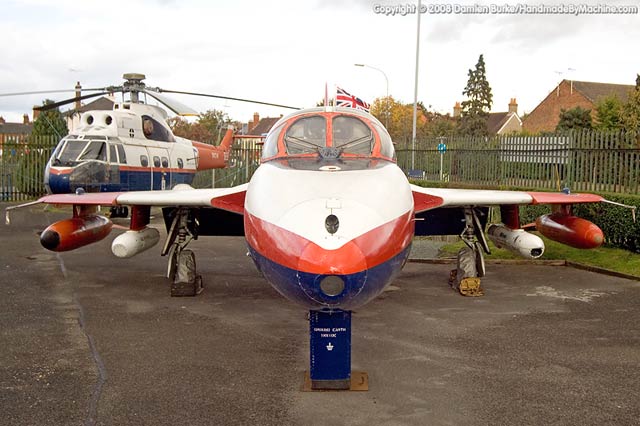Hawker Hunter - Survivor WV383
T.7 WV383 - Farnborough Air Sciences Trust, Farnborough, Hampshire
 |
Hunter T.7 WV383 at Farnborough, 16th October 2008; Damien Burke
Built as an F.4 and first flown in 1955, WV383 was damaged in a wheels-up landing in 1956 and after repair was returned to Hawkers for conversion to a T.7. Returned to the RAF in 1959, she served with 79 and 4 Squadrons then 28 and 20 Squadrons in the Far East before going into storage for a period and then being issued to RAE Farnborough in 1971. Two years later she went to Cranfield and was fitted with twin Head-Up Displays and a TV camera in the nose as part of trials to investigate the feasibility of pilots flying using a TV image of the outside world. By 1975 she was also using low light TV cameras, and continued night vision trials into the 1980s using forward looking infra red (FLIR) and also Night Vision Goggles (NVGs). It was during these trials she gained the name painted on her nose - HECATE - Lady of the Night. Her final trials work was on the PENETRATE programme - a podded systems demonstrator to enhance the high-speed low-level capability of the aircraft at night and in adverse weather. She was last flown in 1998, and QinetiQ (the successors of RAE) donated her to FAST and she was transported to storage at Farnborough in 2000, and reassembled and put on display in 2002. She's seen here outside the FAST museum building - she's visible from the road outside but sadly impossible to photograph from there due to the railings - so you'll just have to visit the museum when it's open to see her!
Information on this page current as of 16/10/2008, last updated by Damien |
Find other photos of WV383 on the following sites:
Air-Britain - Airliners.net - Airplane-Pictures.net - flickr.com - WorldAirPics.com - JetPhotos.net - PlanePictures.net
